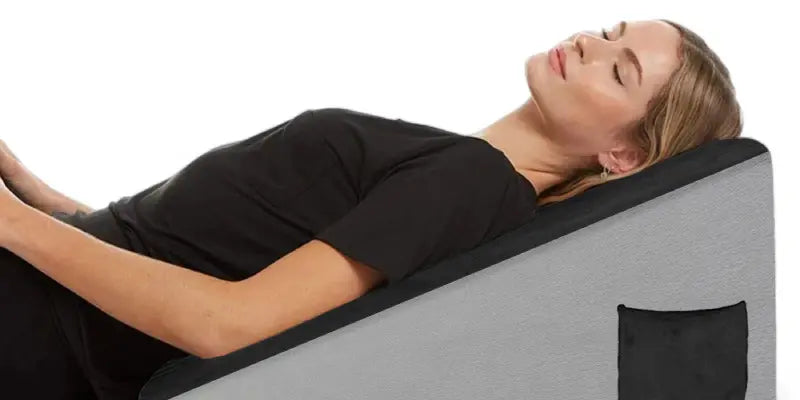
Benefits of Wedge Pillows And How to Use It
You must have seen triangular-shaped pillows and wondered if they are comfy and how they are used. A wedge is a triangular pillow made of relatively firm foam with an angle of 20 to 40 degrees.
A wedge pillow can raise the head 6 to 8 inches, which can be beneficial if you snore, have frequent acid reflux, have swollen ankles, or have another problem that worsens when lying down or sleeping on your back.
While most individuals use a feather, down, or memory foam cushion as their primary sleeping pillow, the wedge pillow is gaining popularity. If you haven't considered one, maybe you should.
Benefits of Wedge Pillow
Here are the benefits of wedge pillows for use in different situations:
Snoring and Sleep Apnea
When you fall asleep, your tongue and other oral tissues relax so much that they can block your throat and limit your airways. This causes snoring or more severe sleep apnea. This is when you stop breathing for brief periods of time during the night.
Elevating the head and upper torso is thought to keep the airways open, preventing disturbances in breathing. Sleeping with a wedge pillow can also help avoid snoring.
Acid Reflux/GERD
Acid reflux, also known as Gastroesophageal Reflux Disease (GERD), occurs when stomach acid flows up into the esophagus, throat, and mouth, causing pain, discomfort, and sleep disturbance.
It commonly happens at night because stomach acid moves more easily when your body is horizontal. Using a wedge pillow to raise your upper back can assist gravity keep the acid down.
Neck and Back Pain
When it comes to back support, some people prefer two wedge pillows over one. This is accomplished by arranging one pillow at the top of the bed and another at the bottom of the bed, with their tapered ends facing each other.
The wedge plus cushion at the head of the bed should be adjusted to raise the head and shoulders. The thighs should rest against the pillow's upward slope at the foot of the bed, with the upper edge supporting the backs of the knees.
This position can help to relieve pressure throughout the length of the spine, allowing for more peaceful sleep and you wake up without back pain.
Swelling
Elevation is advised for swelling or inflammation caused by surgery, injury, or persistent illness. A wedge pillow might help you comfortably elevate swollen body areas when lying down.
To elevate your knee, lay the thick end of the wedge under it while lying on your back. You might also use the thick edge to support swollen feet, ankles, or calves.
This can also help with fluid retention caused by pregnancy or long periods of sitting.
In addition to a regular wedge, there are specific pillows available with a small slope up to a flat region where your lower legs and feet can rest.
Cough and post-nasal drip
Post-nasal drip is caused by mucus pouring down the back of the throat and into the airways, and it can cause problems both when sleeping and when waking. For many, this results in a persistent cough that never seems to go away.
Sleeping on a wedge pillow elevates the upper body just enough to prevent mucus from accumulating in the back of the throat. Ultimately, this lowers inflammation and irritation, resulting in improved overall health.
How to Use a Wedge Pillow
Most people can’t figure out how to use a wedge pillow. Listed below are the many positions in which you can use a wedge pillow, as well as how to sleep on one.
Under the Knees
Elevating your upper body also relieves strain on the lumbar spine, which reduces lower back pain while sleeping. Back sleepers can place a wedge pillow between their legs, with the taller corner beneath the knees. Elevation increases circulation, reducing swelling and aching feet and lowering the likelihood of varicose veins.
Upright Recline
If you like to use your bed as a regular office or a cozy spot to watch TV, read books, or write, you can place the pillow vertically upright behind you. To properly set this posture, place the pillow's wide end on your mattress and lean the flat side against the head of your bed or the wall. You will then be able to recline comfortably in an upright position without putting strain on your back, shoulders, or neck.
Gentle Slope
When sleeping on your back or side, position the wedge pillow's thickest corner under your head and the thinnest edge beneath your shoulders. Sleeping at a slight inclination can help to maintain good spinal alignment, improve respiratory health, and reduce aches and suffering.
On Your Stomach
Sleeping on your stomach can cause muscle tension, restrict respiration, and exacerbate pre-existing conditions. It is considered to be the worst sleeping position. For this reason, we do not advocate sleeping on your stomach using a wedge pillow. If you need to sleep on your stomach, place a conventional pillow beneath your abdomen and pelvis for support.
On Lap
You can use the wedge pillow to create a little surface for a book, journal, or laptop while sitting. Sit with the wedge pillow's tiniest corner facing you, and lay your book or laptop on its slant.
Conclusion
Wedge pillows are a simple yet effective approach to reduce pain and promote deeper sleep. These pillows are affordable and may be used in a variety of ways to provide excellent relief and comfort, even if you do not have any specific health conditions.
If you have sleep apnea, snoring, acid reflux, lower back pain, or poor circulation, a wedge pillow can help you adjust your sleeping posture and achieve more restful sleep. Plus, wedge pillows are readily available, long-lasting, and inexpensive.
The Sleepsia Wedge pillow is made of firm, supportive restorative memory foam. Furthermore, this very soft pillow gives you adequate support to relax and sleep well. Furthermore, it provides relief and adequate support for your body when you relax in bed.








